Extreme time-domain astrophysics
A characteristic yardstick for measuring black hole jets
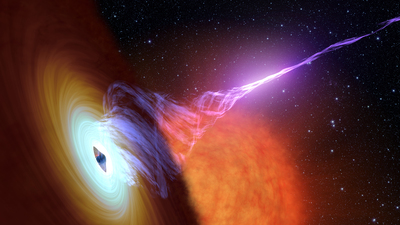 Energetic beams of plasma erupting from close to black holes are called jets. These can wreak tremendous havoc on their galactic neighbourhoods. Astronomers are trying to understand the mechanism of how jets work. But this is challenging because black holes are located at tremendous distances, and telescopes are not powerful enough to resolve and isolate radiation from this region. In this study, we found fast optical flares (the raging red ones reported last year) to be delayed with respect to X-rays when jet emission was strong. This implies that fast optical flaring originates in the jet base, thus effectively isolating emission from this region. In addition, the time delay constrains the size of this zone where plasma is being strongly accelerated. This provides a boundary condition to understand jet acceleration physics in stellar-mass as well as supermassive black holes.
Energetic beams of plasma erupting from close to black holes are called jets. These can wreak tremendous havoc on their galactic neighbourhoods. Astronomers are trying to understand the mechanism of how jets work. But this is challenging because black holes are located at tremendous distances, and telescopes are not powerful enough to resolve and isolate radiation from this region. In this study, we found fast optical flares (the raging red ones reported last year) to be delayed with respect to X-rays when jet emission was strong. This implies that fast optical flaring originates in the jet base, thus effectively isolating emission from this region. In addition, the time delay constrains the size of this zone where plasma is being strongly accelerated. This provides a boundary condition to understand jet acceleration physics in stellar-mass as well as supermassive black holes.
Published as: "An elevation of 0.1 light-seconds for the optical jet base in an accreting Galactic black hole system", Nature Astronomy (2017).
[Read my press release on this]Raging red black hole flashing faster than the blink of an eye
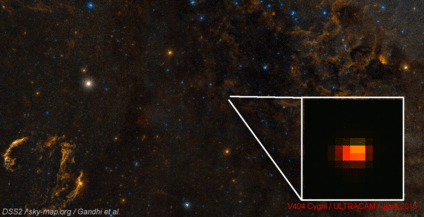 Violent red flashes, lasting just fractions of a second, have been observed during one of the brightest black hole outbursts in recent years. In June 2015, a black hole called V404 Cygni underwent dramatic brightening for about two weeks, as it devoured material that it had stripped off an orbiting companion star. In a new study, published in the journal Monthly Notices of the Royal Astronomical Society, an international team of astronomers, led by the University of Southampton, report that the black hole emitted dazzling red flashes lasting just fractions of a second, as it blasted out material that it could not swallow. The astronomers associated the red colour with fast-moving jets of matter that were ejected from close to the black hole. These observations provide new insights into the formation of such jets and extreme black hole phenomena.
Violent red flashes, lasting just fractions of a second, have been observed during one of the brightest black hole outbursts in recent years. In June 2015, a black hole called V404 Cygni underwent dramatic brightening for about two weeks, as it devoured material that it had stripped off an orbiting companion star. In a new study, published in the journal Monthly Notices of the Royal Astronomical Society, an international team of astronomers, led by the University of Southampton, report that the black hole emitted dazzling red flashes lasting just fractions of a second, as it blasted out material that it could not swallow. The astronomers associated the red colour with fast-moving jets of matter that were ejected from close to the black hole. These observations provide new insights into the formation of such jets and extreme black hole phenomena.
Published as: "Furiously fast and red: sub-second optical flaring in V404 Cyg during the 2015 outburst peak", Mon. Not. Roy. Astron. Soc. 459 (2016), page 554.
[Read my press release on this]Rare images of mid-infrared flaring black hole jet captured
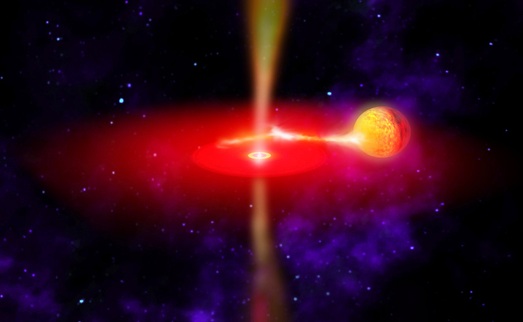 'Jets' are ultra-fast streams of matter flowing out from black hole environments. Black holes can somehow channel and energize matter so that it emerges as a narrow, pencil beam extending vast distances out into space, like an archer who unfailingly shoots to hit the target each time. How does nature accomplish this? To understand this, we need to study the innermost parts of the jets closest to the black hole. For decades, astronomers have studied the outer regions of jets using radio telescopes. Now my work has zoomed in on the jet base by using mid-infrared radiation. NASA's WISE mission detected flaring light from the base of a black hole jet in our Galaxy, and showed beyond doubt that the physical conditions there are incredibly chaotic and variable. We are now in a position to better understand the workings of these enigmatic jets.
'Jets' are ultra-fast streams of matter flowing out from black hole environments. Black holes can somehow channel and energize matter so that it emerges as a narrow, pencil beam extending vast distances out into space, like an archer who unfailingly shoots to hit the target each time. How does nature accomplish this? To understand this, we need to study the innermost parts of the jets closest to the black hole. For decades, astronomers have studied the outer regions of jets using radio telescopes. Now my work has zoomed in on the jet base by using mid-infrared radiation. NASA's WISE mission detected flaring light from the base of a black hole jet in our Galaxy, and showed beyond doubt that the physical conditions there are incredibly chaotic and variable. We are now in a position to better understand the workings of these enigmatic jets.
Published as: "A variable mid-infrared synchrotron break associated with the compact jet in GX 339-4", Astrophys. Journ. Letters 740 (2011), page L13.
[Read my press release on this]Violent flickering of light from black holes
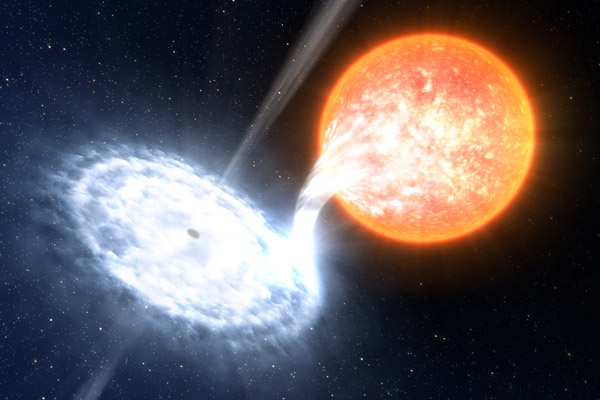 Most of you probably know that black holes are compact and exert a very strong gravitational influence on their environments. Not as well known is the fact that their compactness also means that their immediate environments are highly volatile, and the energy output from this region is hence strongly variable. Very fast changes in the X-ray emissions from around black holes have been studied by astronomers for several decades. Now, using very fast cameras at visible light energies, we have investigated the rapid changes in the *optical* light from black holes in our Galaxies. We found high degrees of flickering, and some very intriguing optical+X-ray variation patterns. Together, these give new insights into the properties of the close-in environments of accreting (i.e. growing) black holes.
Most of you probably know that black holes are compact and exert a very strong gravitational influence on their environments. Not as well known is the fact that their compactness also means that their immediate environments are highly volatile, and the energy output from this region is hence strongly variable. Very fast changes in the X-ray emissions from around black holes have been studied by astronomers for several decades. Now, using very fast cameras at visible light energies, we have investigated the rapid changes in the *optical* light from black holes in our Galaxies. We found high degrees of flickering, and some very intriguing optical+X-ray variation patterns. Together, these give new insights into the properties of the close-in environments of accreting (i.e. growing) black holes.
Published as: "Rapid optical and X-ray timing observations of GX 339-4: flux correlations at the onset of a low/hard state", Mon. Not. Roy. Astro. Soc. 390 L29 (2008).
[Read my press releases on this]Obscured black hole growth
NuLANDS: How many accreting black holes are we missing?
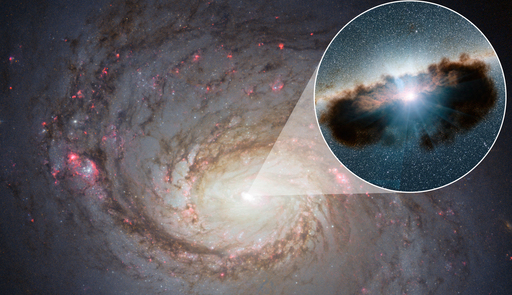 Supermassive black holes tend to be shy eaters. While growing, usually hide behind thick veils of gas and dust. These veils provide the fuel to make the black holes grow, but also mean that we must use special techniques to peer beneath them if we are to learn about growth. I am leading a large survey of growing supermassive black holes in the nearby universe using infrared and X-ray telescopes to overcome the handicap caused by gas and dust. NuLANDS (the NuSTAR Local Agn NH Distribution Survey) aims to robustly quantify the number of heavily obscured actively growing supermassive black holes and to measure their growth rates.
[Go to NuLANDS webpage]
Supermassive black holes tend to be shy eaters. While growing, usually hide behind thick veils of gas and dust. These veils provide the fuel to make the black holes grow, but also mean that we must use special techniques to peer beneath them if we are to learn about growth. I am leading a large survey of growing supermassive black holes in the nearby universe using infrared and X-ray telescopes to overcome the handicap caused by gas and dust. NuLANDS (the NuSTAR Local Agn NH Distribution Survey) aims to robustly quantify the number of heavily obscured actively growing supermassive black holes and to measure their growth rates.
[Go to NuLANDS webpage]
The smoldering embers of black hole heating
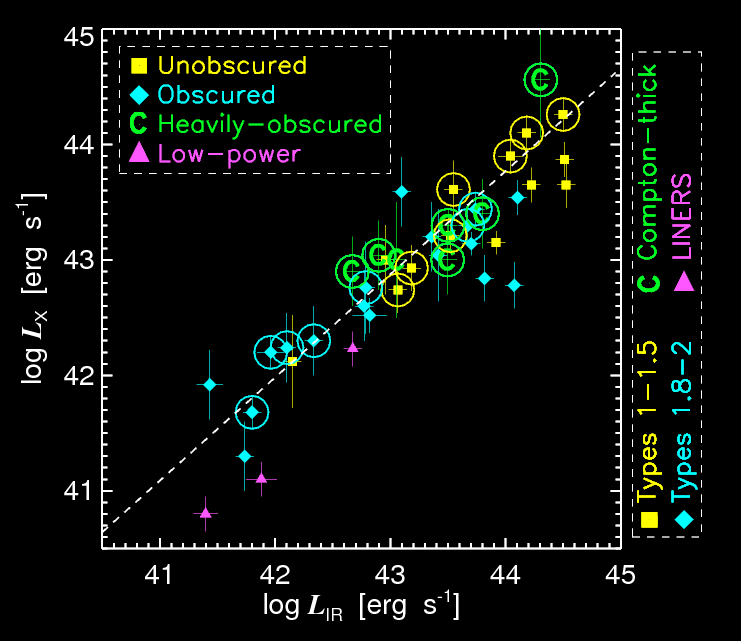 Every large galaxy is now known to contain a heavy-weight 'super-massive' black hole weighing millions to billions of Suns. In some cases, these are actively swallowing matter, growing and shining in the process. Despite their radiance, it has not been easy for astronomers to find all such active black holes. This is because galactic core regions are crowded places, with obscuring gas & dust, as well as young and bright stars all jostling about in the same space, often smothering the black hole within. Using some of the largest telescopes ever built (Europe's Very Large Telescope), we have successfully resolved the nuclear black holes in nearby galaxies from the surrounding melee of contaminating sources, in infrared light. This enabled us to uncover a very close relationship between the intrinsic black hole power (measured via X-ray observations) and the infrared light that results from the black hole heating of surrounding dust clouds. This gives a new handle to probe obscured black holes very accurately, a problem that has long plagued workers in the field.
Every large galaxy is now known to contain a heavy-weight 'super-massive' black hole weighing millions to billions of Suns. In some cases, these are actively swallowing matter, growing and shining in the process. Despite their radiance, it has not been easy for astronomers to find all such active black holes. This is because galactic core regions are crowded places, with obscuring gas & dust, as well as young and bright stars all jostling about in the same space, often smothering the black hole within. Using some of the largest telescopes ever built (Europe's Very Large Telescope), we have successfully resolved the nuclear black holes in nearby galaxies from the surrounding melee of contaminating sources, in infrared light. This enabled us to uncover a very close relationship between the intrinsic black hole power (measured via X-ray observations) and the infrared light that results from the black hole heating of surrounding dust clouds. This gives a new handle to probe obscured black holes very accurately, a problem that has long plagued workers in the field.
Published as: "Resolving the mid-infrared cores of local Seyferts", Astron. Astrop. 502 (2009), page 457.
Cosmological growth and evolution of black holes
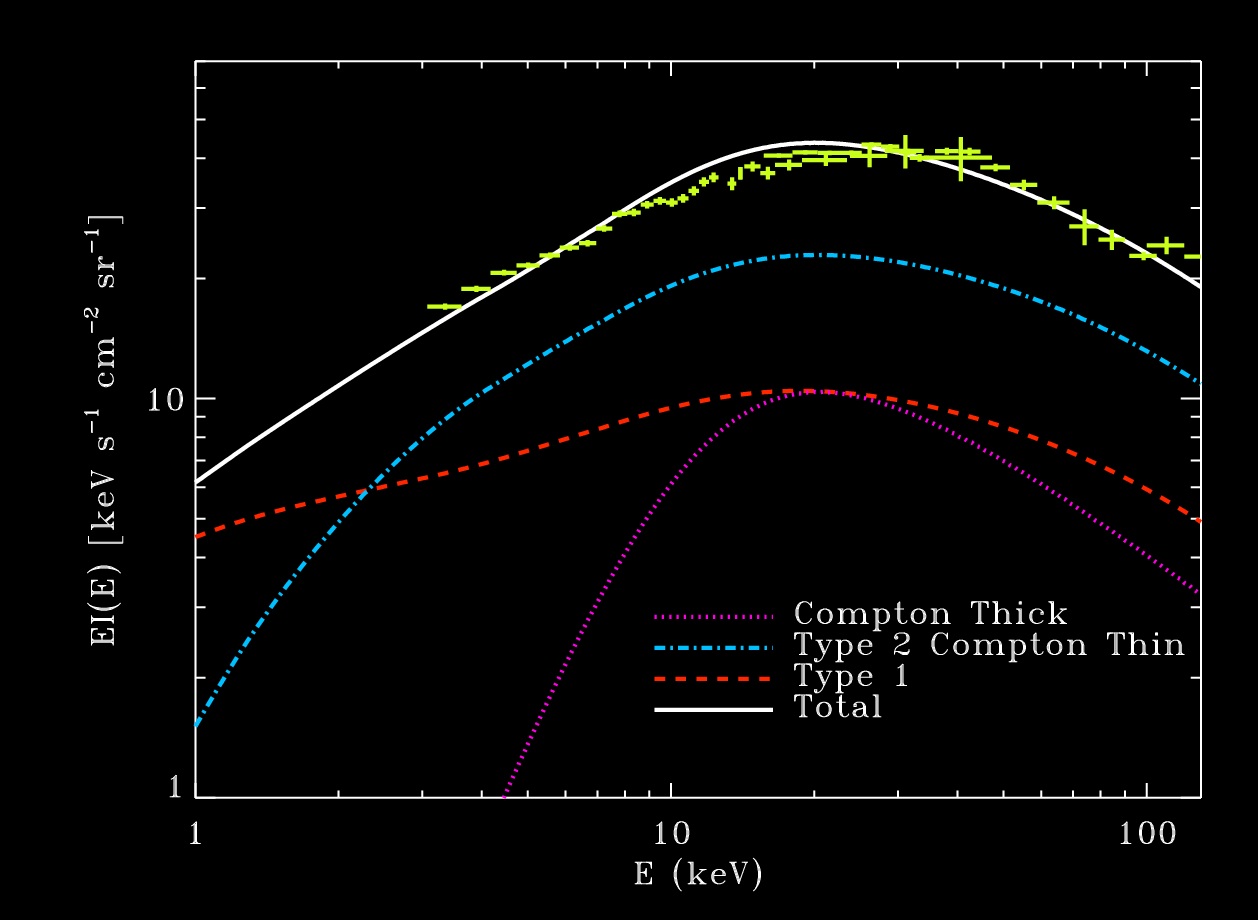 Many of you may know about the cosmic microwave background as being a remnant of the big bang. The cosmic X-ray background (XRB) radiation, on the other hand, dominates the X-ray sky and is a result of the integrated emission from obscured and unobscured accreting super-massive black holes spread out in space as well as time (the image on the left shows the XRB spectrum). So it is crucial for understanding the global relevance of accretion and black hole growth. In 2003, we worked out a model whereby obscured black hole evolution is closely linked to the evolution of powerful obscured star-formation processes. And in 2007, we incorporated general relativistic effects into black hole models, demonstrating that gravitational bending of light in deep potential wells of spinning black holes could modify estimates of the accretion energy density of the Cosmos.
Many of you may know about the cosmic microwave background as being a remnant of the big bang. The cosmic X-ray background (XRB) radiation, on the other hand, dominates the X-ray sky and is a result of the integrated emission from obscured and unobscured accreting super-massive black holes spread out in space as well as time (the image on the left shows the XRB spectrum). So it is crucial for understanding the global relevance of accretion and black hole growth. In 2003, we worked out a model whereby obscured black hole evolution is closely linked to the evolution of powerful obscured star-formation processes. And in 2007, we incorporated general relativistic effects into black hole models, demonstrating that gravitational bending of light in deep potential wells of spinning black holes could modify estimates of the accretion energy density of the Cosmos.
Published as: "X-ray background synthesis: the infrared connection", Mon. Not. Roy. Astron. Soc. 339 1095 (2003), and "Constraints on light bending and reflection from the hard X-ray background", Mon. Not. Roy. Astron. Soc. 382 1005 (2003).
Other Highlights
Finding a rare gem of a star
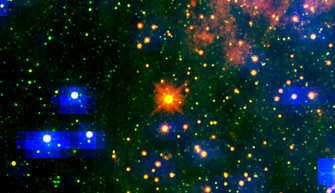 Stars hardly change over the lifetime of a human being. But near the end of their lives, stars can undergo dramatic eruptions of nuclear fusion, expansion and dust creation within a timespan of just a few years. Catching stars in this phase gives a precious 'real-time' view into stellar evolution and the processes of scattering of dust and molecules in the cosmos - the building blocks out of which life arises. I have identified a star which appears to have undergone such a dust eruption in the very recent past (around 1998). This is likely to be a unique object captured at just the right time, and provides a glimpse of the distant future fate of our own Sun.
Stars hardly change over the lifetime of a human being. But near the end of their lives, stars can undergo dramatic eruptions of nuclear fusion, expansion and dust creation within a timespan of just a few years. Catching stars in this phase gives a precious 'real-time' view into stellar evolution and the processes of scattering of dust and molecules in the cosmos - the building blocks out of which life arises. I have identified a star which appears to have undergone such a dust eruption in the very recent past (around 1998). This is likely to be a unique object captured at just the right time, and provides a glimpse of the distant future fate of our own Sun.
Published as: "Dramatic infrared variability of WISE J1810-3305: catching early dust ejection during the thermal pulse of an AGB star?", Astrophys. Journ. Letters 751 (2012), in press.
Exquisitely sharp view of the heart of a starburst
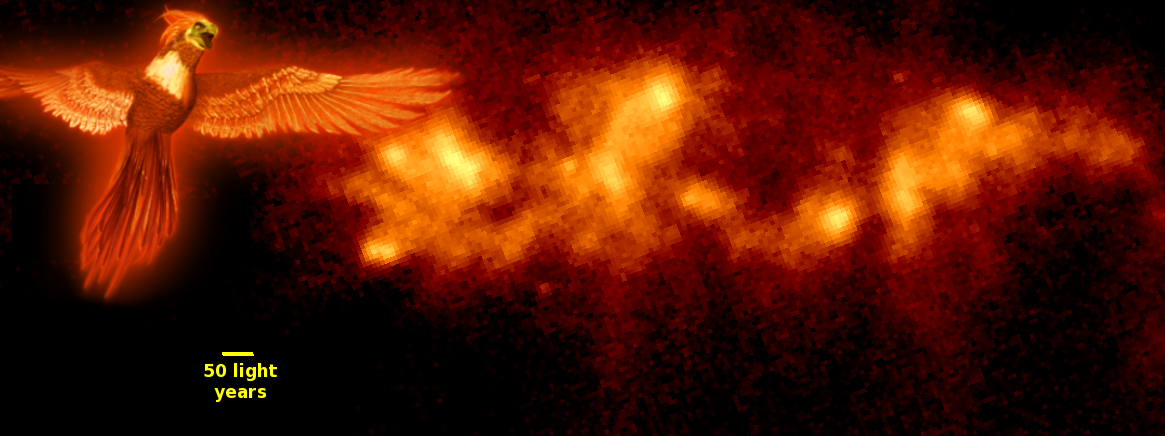 Like people, galaxies are born, grow old and the stars within them eventually die. Our Milky Way galaxy may be considered a "middle-aged" system. If we want to study galactic youth, one must turn to starburst galaxies, which are creating new stars at rates far surpassing our own. Much of their emitted light emerges in the infrared, and we have studied the most famous of starbursts, Messier 82, capturing the sharpest view of the heart of this galaxy to date. What we see is vast quantities of hot dust streaming out from various sites of origin around the inner ~1000 light years of the galaxy, powered by the combined energy of many millions of young stars. The stars themselves are being hidden by the dust and are invisible to optical telescopes. Not only does this open a research window into our galaxy's past, the large telescope (Subaru) that we used produces exquisite images bridging the gap between science and art. Do you see the resemblance to a beloved magical creature?
Like people, galaxies are born, grow old and the stars within them eventually die. Our Milky Way galaxy may be considered a "middle-aged" system. If we want to study galactic youth, one must turn to starburst galaxies, which are creating new stars at rates far surpassing our own. Much of their emitted light emerges in the infrared, and we have studied the most famous of starbursts, Messier 82, capturing the sharpest view of the heart of this galaxy to date. What we see is vast quantities of hot dust streaming out from various sites of origin around the inner ~1000 light years of the galaxy, powered by the combined energy of many millions of young stars. The stars themselves are being hidden by the dust and are invisible to optical telescopes. Not only does this open a research window into our galaxy's past, the large telescope (Subaru) that we used produces exquisite images bridging the gap between science and art. Do you see the resemblance to a beloved magical creature?
Published as: "Diffraction-limited Subaru imaging of M82: sharp mid-infrared view of the starburst core", Pub. Astron. Soc. Japan 63 (2011), page 505.
[Read my press releases on this]- © Poshak Gandhi
- Design: HTML5 UP